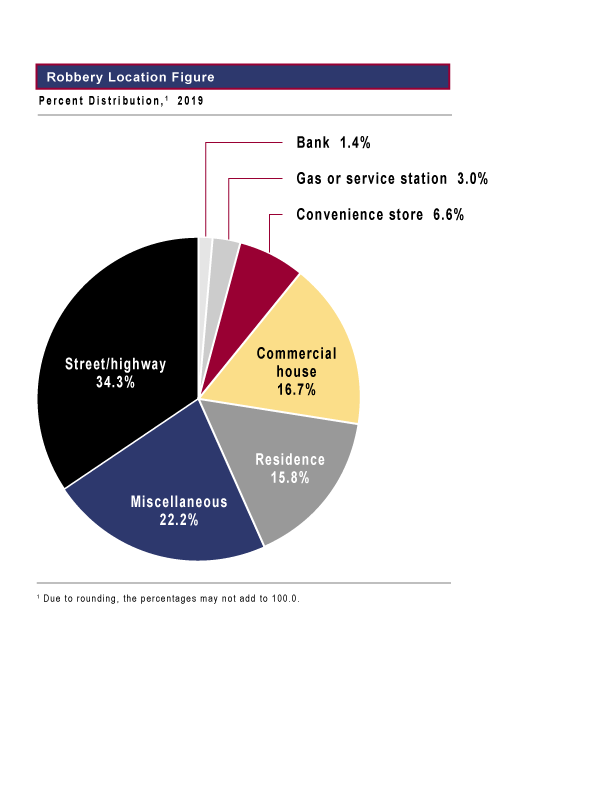Robbery
Definition
The FBI’s Uniform Crime Reporting (UCR) Program defines robbery as the taking or attempting to take anything of value from the care, custody, or control of a person or persons by force or threat of force or violence and/or by putting the victim in fear.
Overview
- There were an estimated 267,988 robberies nationwide in 2019. The estimated number of robberies decreased 4.7 percent from the 2018 estimate and decreased 18.3 percent from the 2015 estimate. The 2019 estimate was down 27.4 percent from the 2010 estimate. (See Tables 1 and 1A.)
- The estimated robbery rate of 81.6 per 100,000 inhabitants in 2019 showed a decrease of 5.2 percent when compared with the 2018 rate. (See Tables 1 and 1A.)
- In 2019, the average dollar value of property stolen per reported robbery was $1,797. Robberies accounted for an estimated $482 million in losses. Banks experienced the highest average dollar loss at $4,213 per offense. (Based on Tables 1 and 23.)
- Among the robberies for which the UCR Program received weapon information in 2019, strong-arm tactics were used in 44.8 percent, firearms in 36.4 percent, and knives or cutting instruments in 8.5 percent. Other dangerous weapons were used in 10.3 percent of robberies in 2019. (Based on Table 19.)
Expanded data
Expanded offense data are the details of the various offenses that the UCR Program collects beyond the count of how many crimes law enforcement agencies report. These details may include the type of weapon used in a crime, type or value of items stolen, and so forth. In addition, expanded data include trends (for example, 2-year comparisons) and rates per 100,000 inhabitants.
Expanded information regarding robbery is available in the following tables:
- Location Type, average value of items stolen by location per robbery: Table 23
- Robbery Table 1, “Robbery, Location, Percent Distribution by Region, 2019”
- Robbery Table 2, “Robbery, Location, Percent Distribution by Population Group, 2019”
- Robbery Table 3, “Robbery, Types of Weapons Used, Percent Distribution by Region, 2019”
Robbery Location Figure
This figure is a pie chart that shows the percentages of robbery offenses by location type in 2019. In the nation, 34.3 percent of robbery offenses occurred on streets or highways, 16.7 percent occurred at commercial houses, 15.8 percent occurred at residences, 6.6 percent occurred at convenience stores, 3.0 percent occurred at gas or service stations, 1.4 percent occurred at banks, and 22.2 percent occurred at miscellaneous locations.


